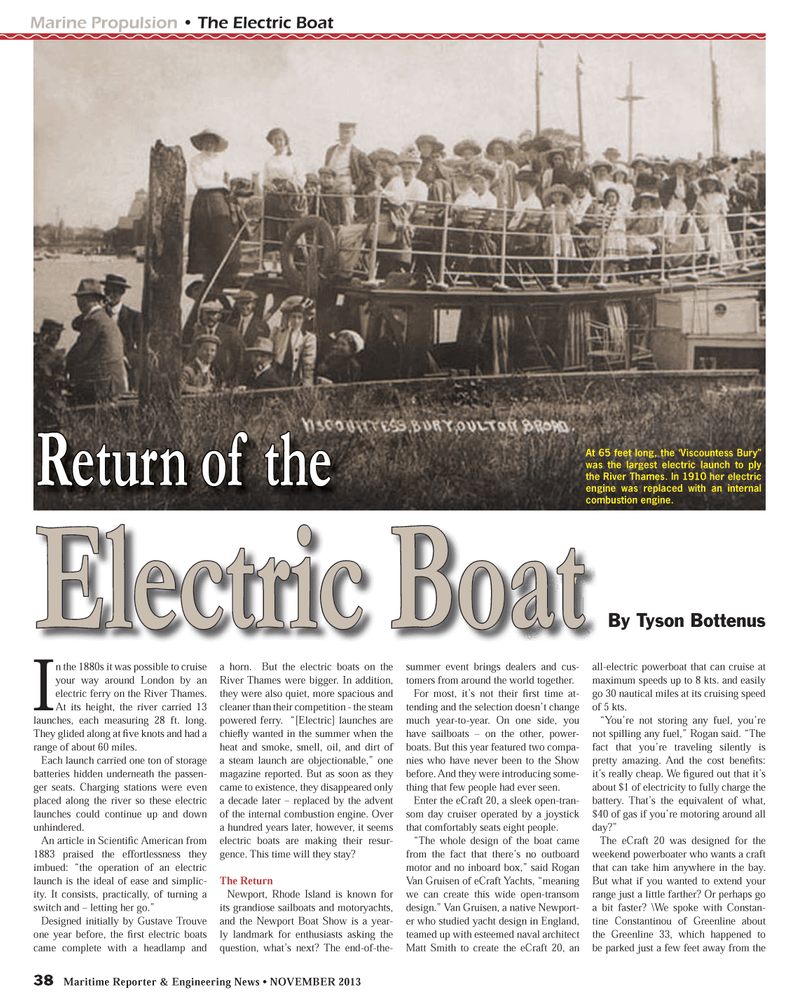
Page 38: of Maritime Reporter Magazine (November 2013)
Marine Propulsion Annual
Read this page in Pdf, Flash or Html5 edition of November 2013 Maritime Reporter Magazine
38 Maritime Reporter & Engineering News ? NOVEMBER 2013 Marine Propulsion ? The Electric BoatIn the 1880s it was possible to cruise your way around London by an electric ferry on the River Thames. At its height, the river carried 13 launches, each measuring 28 ft. long. They glided along at Þ ve knots and had a range of about 60 miles. Each launch carried one ton of storage batteries hidden underneath the passen-ger seats. Charging stations were even placed along the river so these electric launches could continue up and down unhindered. An article in ScientiÞ c American from 1883 praised the effortlessness they imbued: ?the operation of an electric launch is the ideal of ease and simplic-ity. It consists, practically, of turning a switch and ? letting her go.? Designed initially by Gustave Trouve one year before, the Þ rst electric boats came complete with a headlamp and a horn. But the electric boats on the River Thames were bigger. In addition, they were also quiet, more spacious and cleaner than their competition - the steam powered ferry. ?[Electric] launches are chieß y wanted in the summer when the heat and smoke, smell, oil, and dirt of a steam launch are objectionable,? one magazine reported. But as soon as they came to existence, they disappeared only a decade later ? replaced by the advent of the internal combustion engine. Over a hundred years later, however, it seems electric boats are making their resur- gence. This time will they stay? The ReturnNewport, Rhode Island is known for its grandiose sailboats and motoryachts, and the Newport Boat Show is a year-ly landmark for enthusiasts asking the question, what?s next? The end-of-the- summer event brings dealers and cus-tomers from around the world together. For most, it?s not their Þ rst time at- tending and the selection doesn?t change much year-to-year. On one side, you have sailboats ? on the other, power- boats. But this year featured two compa-nies who have never been to the Show before. And they were introducing some- thing that few people had ever seen.Enter the eCraft 20, a sleek open-tran-som day cruiser operated by a joystick that comfortably seats eight people. ?The whole design of the boat came from the fact that there?s no outboard motor and no inboard box,? said Rogan Van Gruisen of eCraft Yachts, ?meaning we can create this wide open-transom design.? Van Gruisen, a native Newport- er who studied yacht design in England, teamed up with esteemed naval architect Matt Smith to create the eCraft 20, an all-electric powerboat that can cruise at maximum speeds up to 8 kts. and easily go 30 nautical miles at its cruising speed of 5 kts. ?You?re not storing any fuel, you?re not spilling any fuel,? Rogan said. ?The fact that you?re traveling silently is pretty amazing. And the cost bene Þ ts: it?s really cheap. We Þ gured out that it?s about $1 of electricity to fully charge the battery. That?s the equivalent of what, $40 of gas if you?re motoring around all day??The eCraft 20 was designed for the weekend powerboater who wants a craft that can take him anywhere in the bay. But what if you wanted to extend your range just a little farther? Or perhaps go a bit faster? \We spoke with Constan- tine Constantinou of Greenline about the Greenline 33, which happened to be parked just a few feet away from the Return of the Return of the Electric Boat Electric BoatAt 65 feet long, the ?Viscountess Bury? was the largest electric launch to ply the River Thames. In 1910 her electric engine was replaced with an internal combustion engine.By Tyson Bottenus MR #11 (34-41).indd 38MR #11 (34-41).indd 3811/13/2013 12:00:32 PM11/13/2013 12:00:32 PM

 37
37

 39
39
